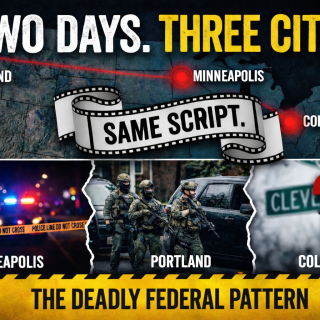As an active and now retired professor, I live in one of the city of Columbus’ older and more attractive neighborhoods. Called the University District, it abuts the Ohio State University (OSU) campus. Historically, that has been one of its assets but over the past few decades, it has become the major cause of its demise. The Columbus Police Department (CPD), the City of Columbus, the disparate group of large corporate landlords and management companies, and to a lesser extent the city’s media join in responsibility. This pattern of active and passive collusion is rarely admitted or even acknowledged (and if then misrepresented). It is a tragedy in terms of neighborhood decline; dangers to residents young and old; damage to persons, property, and life; and daily crimes and misdemeanors ranging from robbery, assault, and shootings; to property damage; illegal fireworks and gunshots; public drunkenness; noise, trash, and property desecration; and uncivil conduct. This must end now for the best interests of all parties including the students, most of whom are innocent victims.
Several myths compete to explain the current situation. As myths they may contain a grain or two of truth, but overall, each one is demonstrably false. Myth 1 claims that the University District long experienced a “Golden Age” as a bucolic middle-class neighborhood of professionals, many of them associated with OSU. According to the myth, over the years the UD “declined” to a sea of unruly, immature students renting rooms in boarding houses or living in fraternities and sororities and committing endless acts of unlawfulness and incivility. Writers who are not professional historians repeated this myth—never defined or documented—in speech and print through self-publishing or vanity presses.
The research of urban historian Ellen Manovich in particular documents a contrasting reality. No “golden age” ever existed. The UD was always a mixed neighborhood of owners and other residents, older and younger. Renters, however, typically lived with owner-occupants not in the dwellings of off-site landlords. OSU did not have student housing until after the post-World War II GI Bill. The neighborhood was always dynamic, but change accelerated from the 1990s. We witness it daily from our 106-year-old house where we have lived for 17 years. (Some of our neighbors have lived in the area much longer.) We also see that the most significant problems stem from a minority of students.
Myth 2 derives from the first one. With no evidence and only vague impressions, it asserts that the “decline” is both new and sudden, and that responsibility lies with the students alone. Manovich’s and others’ research shows that this is false.
Myth 3 is more incomplete, face-saving, and distracting than false. It places the blame for decline principally on the landlords who rent to the students, and not on OSU, CPD, or the city of Columbus.
Myth 4 alleges that an apparent upsurge in robbery, violence, and assault committed by criminal outsiders, not students, is both new and unprecedented. This assertion, which might seem to at least partly exonerate OSU, is untrue. These crime patterns are not novel but the continuation of trends. In the wake of spikes occurring throughout the city and heightened media attention, perceiving and reporting them as unprecedented is inaccurate.
Five parties share responsibilities for the tragedy. On some matters, they work together, in others independently. They are OSU, CPD, the City of Columbus, the major owners and managers of rental properties, and to a lesser extent Columbus’ media.
Although you would never know by speaking with university representatives—as my neighbors and I have long attempted—OSU bears the greatest share of responsibility. Research shows that the university has never taken its civic and legal obligations seriously, including to its own students who have always resided in the area. For a relatively short time, OSU promoted the pretense of responsibility. They had occasional patrols by campus police, a hot-line for reporting problems, and administrators including former president Gordon Gee and student life director Willie Young who visited the area. Much of that was self-promotion. Over the past decade or so, these efforts ceased without announcement or explanation. There is now a cold line from which we have never had a response or acknowledgement.
Also unstudied and unacknowledged is the active work of Campus Partners—OSU’s nontransparent development arm—in advancing neighborhood change away from owner-occupiers and toward developers. My preliminary research revealed that they frequently did business at a financial loss.
Both Campus Partners and other parts of the OSU administration flailed and failed in attempting a much-too-limited and unadvertised incentive program to attract new homeowners to the UD. With a graduate research assistant, I began a project on Campus Partners several years ago; it ended because of its unwillingness to share data and other information (despite being part of a public university).
When pressed today, OSU’s Office of Student Life and its Director of Public Safety point to emails to students that contain no substantive content and repeated references to sketchy public safety “recommendations” that have not yet been implemented and may not be implementable in their proposed forms. When asked directly by residents and the media, they distract and do not respond fully or accurately. They regularly refer to the OSU Safety Alert email system, never acknowledging how many hours late the notices appear and their incomplete, sometimes offensive wording.
To take a few daily examples, no one informs students that city laws prohibit riding electronic scooters and bicycles on sidewalks or that scooters cannot be left to litter walks or yards. Students are unaware that parking is not permitted within five feet of a driveway or alley, or that the city has formal limits on noise and public assembly. Not surprisingly, these are persistent problems.
OSU administrators do not understand that they bear singular responsibility to inform and educate the students about the laws that apply to life in the UD and their civic community obligations. My neighboring students as well as the students I taught from 2004 to my retirement in 2017 want to know this vital information.
OSU’s long-time substitute for policies, marking the terms of a number of presidents, is what I call “leadership by sloganeering.” Gordon Gee was the master but others followed. With respect to the UD, it is now the “residential experience” and “60,000+ students. 100+ countries. One University District.” The UD does not have a population of 60,000 students or represent 100 countries. Slogans may have a place in promoting products, but they do not substitute for substance or policy.
CPD bears a considerable degree of fault, both by itself and in its inconsistent relationships with OSU. CPD does its best to ignore the UD. It is often nonresponsive to non-emergency calls. When the police do respond, they rarely take action and often are seen toasting or saluting drunken and noise-violating students. Some CPD officers tell older, owner-occupying, long-term residents that we “don’t belong” in the neighborhood and too often treat us with disrespect. That is my own and my neighbors’ experience.
The most dramatic recent failure of CPD is last March’s ChittFest student and non-student riot. Despite ample advance warning that the annual block party coinciding with the spring football practice game would be unusually large, neither CPD nor campus police prepared or responded. I watched from my dining room windows as uncommonly large numbers of students filled the sidewalks all day, with mounted CPD officers watching them.
After the riot broke out, including the overturning of a half-dozen vehicles and despite more than 60 calls to 911, CPD did not respond for more than four hours. They arrived only after the riotous party began to break up. They made no on-scene arrests. Their very tardy excuse: their inaction resulted from an unannounced change in their “use of force policy.” They apparently expect the citizens of Columbus to believe they are unable to respond to an active, violent crime scene without exercising excessive force. What a powerful self-indictment.
Home football games and fraternity-sorority party nights are also regular scenes of predictable violations of laws and ordinances. Neither OSU or CPD take responsible, proactive, or real-time action.
My neighbor, the historic Indianola Presbyterian Church, was desecrated in mid-August. Vandals painted “Your god is dead” on its front doors. Police eventually appeared but have done nothing. The minister has asked repeatedly for a copy of the police report with no response. This outrageous vandalism, very likely committed by drunken students not criminal “outsiders,” has not been reported publicly. I only know because the pastor told me as a friendly neighbor.
The City of Columbus is the third responsible party. Its zoning laws, neighborhood oversight and safety, and other ordinances and regulations are out-of-date, inadequate, and unenforced, a triple whammy of irresponsibility and unresponsiveness. They have not been updated in decades to respond to the changes in the UD and other neighborhoods. Prominent problems lie in zoning of single family vs. congregant housing; property upkeep; and the responsibility for renters’ violations of laws and ordinances. Laws, ordinances, and regulations concerning illegal assemblies, public drunkenness, noise limits, illegal fireworks and gunfire, waste removal, parking, and more are unaddressed and unenforced. Calls to 311 receive attention inconsistently at best. These problems plague the area.
The unregulated, profit-driven landlords and property managers who dominate the rental market in the UD regularly violate laws, codes, ordinance, and regulations. Sometimes this is by ignorance—not a legal excuse—but often by active disregard. They do not respond to the legitimate and often contractual requests and concerns of their tenants, nor to the repeated requests from neighboring owner-occupiers. No one holds them legally accountable.
I acknowledge with gratitude the few single or smaller property owners (some of them former residents) who are immediately and sometimes proactively responsive. But they are not typical. These problems include ever-larger signage on dwellings advertising rooms for rent and names of the property owners. Some of these signs, including students’ banners and yard signs, violate city codes. Despite our requests, city departments rarely respond.
Finally, Columbus’ media merit a lesser but real share of responsibility. First, they have long at least tacitly accepted one or more of the UD’s myths. Second, they tend to accept without research the explanations of these major institutions. Third, with some exceptions, there is insufficient in-depth, investigative reporting. The financial and journalistic decline of the established media and the shift from news reporting to opinion writing exacerbate the problem. In Columbus, the near monopoly of USA Today/Gannett has a chilling effect. Finally, as I have written elsewhere, as part of Columbus’s identity crisis, the city lacks any tradition of responsible, constructive public criticism and active public conversation. My argument is endorsed by reporters but not by editors or managers.
Many solutions and reforms could begin to combat the present and longer-term tragedy of the University District. More slogans, unimplemented recommendations, and temporary lighting with cameras are barely Band-Aids. Developing relevant policies requires another essay, but I suggest some here. There is an urgent need to take coordinated actions.
Harvey J. Graff is Professor Emeritus of English and History at The Ohio State University. Author of many books on social, urban, and educational history, he has written about OSU and the University District and also supervised student research on the area.



